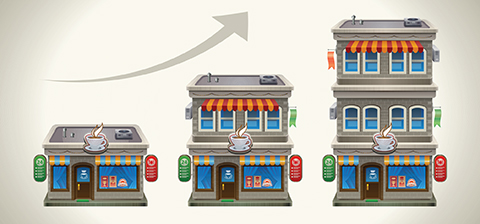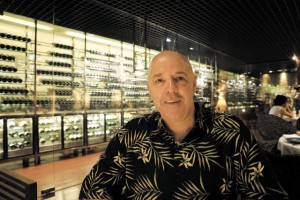

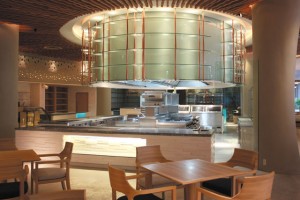 Look at any well-thought out structure or piece of art and if you ever had the chance to speak to the creator, an articulate speech is most likely delivered that speaks volumes about giving each element due attention for they know the importance of the minute things that bring the total sum of things to reality.Similarly, this principle is applied in the designing of a commercial kitchen. Speaking to David J. Kidney of renowned Romano Gatland (professional food service consultants), he does not skimp on the details when planning out a kitchen. A former chef who knows the in-and-outs of the workspace, David is acute on designing a kitchen that is ‘just right’, as much as knowing how to use and treat an ingredient right. The Managing Director of Romano Gatland Asia Pacific has seen his fair share of kitchen designs that are botched up becoming a liability. On-site observations and measurements are taken over by CAD systems that allow designers to draw up a commercial kitchen with technology alone. While David does not resist the use of advanced methods, he asks “does the person putting this together have adequate data and experience to know how to create a good work flow in the kitchen?” Because it is not as simple as placing equipment on a plan but one needs to understand what goes on behind-the-scenes during any operational day of a kitchen. He advises aspiring operators to engage a kitchen designer with some engineering background and experience in a kitchen. A professional designer will understand the complexities of matters such as ventilation, lighting, work process, electrical, water and gas connections all the way to waste management and the impact on a commercial kitchen. The understanding of how each part affects the workspace allows you to begin ‘trouble shooting’ from the start; instead of only working on issues when they arise.
Look at any well-thought out structure or piece of art and if you ever had the chance to speak to the creator, an articulate speech is most likely delivered that speaks volumes about giving each element due attention for they know the importance of the minute things that bring the total sum of things to reality.Similarly, this principle is applied in the designing of a commercial kitchen. Speaking to David J. Kidney of renowned Romano Gatland (professional food service consultants), he does not skimp on the details when planning out a kitchen. A former chef who knows the in-and-outs of the workspace, David is acute on designing a kitchen that is ‘just right’, as much as knowing how to use and treat an ingredient right. The Managing Director of Romano Gatland Asia Pacific has seen his fair share of kitchen designs that are botched up becoming a liability. On-site observations and measurements are taken over by CAD systems that allow designers to draw up a commercial kitchen with technology alone. While David does not resist the use of advanced methods, he asks “does the person putting this together have adequate data and experience to know how to create a good work flow in the kitchen?” Because it is not as simple as placing equipment on a plan but one needs to understand what goes on behind-the-scenes during any operational day of a kitchen. He advises aspiring operators to engage a kitchen designer with some engineering background and experience in a kitchen. A professional designer will understand the complexities of matters such as ventilation, lighting, work process, electrical, water and gas connections all the way to waste management and the impact on a commercial kitchen. The understanding of how each part affects the workspace allows you to begin ‘trouble shooting’ from the start; instead of only working on issues when they arise.
Interestingly, David noted that at times a modern kitchen is more of an emotional experience as the profession has been elevated, making a kitchen more than just a workspace. It has become an avenue for many to showcase their talents but the downside can be “too many cooks might spoil the broth” during the design stages. Food service facilities need to be practical and sustainable and be able to accomplish or satisfy the needs of all parties involved. Growth and business is very competitive and a challenge is having these same parties understand each other, the importance of food and beverage and its solid contribution to any business – this is where consultants, owners and operators must work together to be on the same page. Romano Gatland works on a total design solution that starts from feasibility studies of a concept to developing it and designing it to match the concept – these backend processes are crucial to ensure success. It must be acknowledged that owners and operators have differing viewpoints and priorities such as being high profile versus capital costs. Our industry today has such a large amount of technology and equipment at our disposal, it is important to tender food service facilities to appropriately qualified and experienced companies TO SPECIFICATION and at the same time provide an opportunity for equivalently positioned alternatives to be submitted to ensure the investor has all commercial advantages made available. Base and alternate tenders are then evaluated and compared objectively. In line with that, a consultant takes into consideration numerous points when specifying a product with after-sales support being a key consideration. Equipment that is imported because of a low purchase price with no local support simply ensures the equipment becomes a liability and can contribute to inefficiencies.
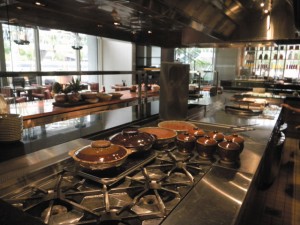
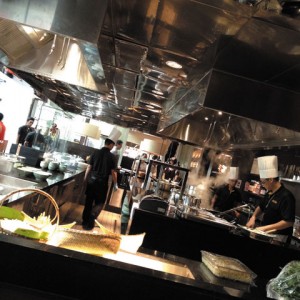 To this, David hopes to see better trained and qualified sales and service personnel in the industry as equipments may be designed with great functions and features but fail as owners are not convinced of its performance due to the poor sales and service support. “And this is one reason why we have a 2 bids system, so that we ensure that the most appropriate equipment is accessible for any specific project”, he said. A question to David about specific equipments that remain unused although a facility is in operation; to which he replied that the industry’s turnover is tremendously high where people come and go all too frequently. As personnel change, it does not make any commercial sense for a kitchen to change equipment based on personal preferences. This is another sound reason why professional planning and design services should be sought after, a facility should be designed from a global perspective and be sustainable for at least 8 years or longer. Personnel turnover also has an impact on the training of equipment systems and format if not addressed adequately, equipment can be left underutilised, creating inefficiencies. The correct training ensures that everyone is familiar with the use and functionality of equipment and can assist in the same personnel being able to trouble shoot issues quickly and take necessary measures of rectification.
To this, David hopes to see better trained and qualified sales and service personnel in the industry as equipments may be designed with great functions and features but fail as owners are not convinced of its performance due to the poor sales and service support. “And this is one reason why we have a 2 bids system, so that we ensure that the most appropriate equipment is accessible for any specific project”, he said. A question to David about specific equipments that remain unused although a facility is in operation; to which he replied that the industry’s turnover is tremendously high where people come and go all too frequently. As personnel change, it does not make any commercial sense for a kitchen to change equipment based on personal preferences. This is another sound reason why professional planning and design services should be sought after, a facility should be designed from a global perspective and be sustainable for at least 8 years or longer. Personnel turnover also has an impact on the training of equipment systems and format if not addressed adequately, equipment can be left underutilised, creating inefficiencies. The correct training ensures that everyone is familiar with the use and functionality of equipment and can assist in the same personnel being able to trouble shoot issues quickly and take necessary measures of rectification.
Three key components of any food service facility are exhaust, refrigeration and warewashing, where incorrect design and specification can lead to poor working conditions, questionable food quality, loss of productivity, wastage of energy all resulting in a poorly functioning working environment and operation. We urge users to seek advice relating to equipment and systems that have a solid after-sales support record and has good presence where you are.
David’s wealth of knowledge and experience, both as a chef and designer spearheads Romano Gatland in the Asia Pacific region. The company’s name is synonymous with commercial kitchen set-ups, having been involved in over 4000 projects since its founding in 1964 that includes corporate, healthcare, correctional facilities, hospitality and educational institutions around the world. In Asia Pacific, their expertise are seen in Grand Hyatt Shenzhen (China), International School of Bangkok (Thailand) Shangri-La’s Mactan Resort and Spa Cebu (Philippines). Its current projects include National University of Singapore UNIVERSITY TOWN Cinnamon Tembusu, Grand Hyatt, Kuala Lumpur, Malaysia, Evason Laamu by Six senses, Maldives and Four Season Doha LAUNDRY, to name a few.
By assembling dedicated teams that are competent in both operations and design, Romano Gatland can plan and execute demands to greatest detail as it also stands firm on not outsourcing or piecing an ad-hoc team to tackle “project-of-the-moment” but relies on its in-house staff that are specialist in various disciplines. The company’s reliability is proven with repeat client projects with Columbia University, Pfizer, JP Morgan Chase, Federal Bureau of Prisons and the New York City Board of Education.
As the global food and hospitality trends constantly changes, one of the most current trend is the ‘going green’ expedition. And Romano Gatland Asia Pacific, anchored by David J. Kidney who constantly work according to his core principles continues to fuse these guidelines in the company’s endeavour of making commercial kitchens more environmentally aware for the future. In the next section, we will explore how you can ‘green’ your kitchen in various departments – the details that make a big difference.
[box style=”rounded” border=”full”] ROMANO GATLAND ASIA PACIFIC SERVICES• Feasibility Studies • Equipment & Technology Education • Concept Planning
• Equipment & Technology Advice • Food Service Facility Design & Planning
• Laundry Design & Planning • Contract Documentation
ROMANO GATLAND ASIA PACIFIC
101, Rama 9, Soi 60 Suanluang, Bangkok 10250, Thailand.
Tel: +66 2 718 9860 | Fax: +66 2 718 9799
[/box]









